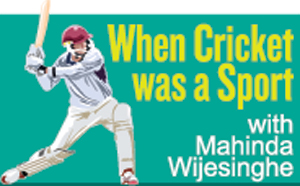Some of the aspects of cricket then
View(s): Cricket is the only sport where (1) a private club “Marylebone Cricket Club, London”, with currently a membership of over 18,000 Full Members and 5,000 Associate Members is responsible for its Laws and (2) in the Preamble to the Laws it is stated that the game should be played not only within the Laws but also within the spirit of the game.
Cricket is the only sport where (1) a private club “Marylebone Cricket Club, London”, with currently a membership of over 18,000 Full Members and 5,000 Associate Members is responsible for its Laws and (2) in the Preamble to the Laws it is stated that the game should be played not only within the Laws but also within the spirit of the game.
It has been estimated that there are 8,000 indigenous sports bring played in the world but none of them can claim the above mentioned (2) criteria mentioned in their Laws. Hence one can assume the unusual position this wonderful game of cricket enjoys.
The reputation of cricket is such that there are two expressions that have been encased into the English language from time immemorial, though the usage currently is much less today. Firstly, the phrase, “it is not cricket” means if someone commits something unfairly. Secondly, “to play a straight bat” would be the opposite of the previous phrase.
However with the advent of money into the game these phrases are now practically defunct, though there are few instances of sportsmanship being displayed on the field of play even at international level. Once a sport becomes an industry then the fate of that sport is inevitably tainted with filthy lucre.
The man responsible for turning the game over to money was an Australian billionaire media magnate, Kerry Packer (1937- 2005), at the time of his death he was the wealthiest man in Australia. He owned the Nine Network TV, and is famous for introducing World Series Cricket in 1977, together with a more dynamic form of television coverage including coloured clothing to players, rules for special field placings, introduction of prepared pitches to enable more matches to be played etc., etc., It was a complete revolution in the game and the players/umpires/officials were well rewarded. This was however a revolution not in keeping with the spirit of the game.
In the pre-1977 era however it was a different ‘ball game’. The players/umpires/officials et al associated in the sport but at great financial personal expense. For instance, the Ceylon players who used to play in the one-day games against England/Australian players when they pass through Ceylon are a case in point. The selected Ceylon players come to the grounds – generally to the Oval – by bus, unless they own a motor bicycle or a car. At the end of the game, each player is paid Rs.15/-, euphemistically termed ‘smoke money’, and have to bring their own cricket kit. However, when such matches are played the ground is packed and the Vanathamulla thugs have a field day. There used to be trees skirting the outside perimeter of the ground. The story goes that the thugs charge -50cts to climb the tree to watch the game but 1Rs. to come down the tree!
The situation in club cricket was not too different. There were not more than 10 clubs (approx.) in the premier division. During the 1960’s each club played the other twice on the basis of once on their own grounds and the return game in the venue of the opposition team. The matches used to start on the Saturday at 1.45 p.m. and on the Sunday at 10 a.m. The most enjoyable game was when we travelled to Dimbulla to play the game against the planters where we were treated royally.
At that time the Board of Control for Cricket did not make any handouts to the clubs, so it was a hand to mouth existence for the poorer clubs. In fact, during some of the games we hand to fend ourselves for their lunch on the Sunday. Attending practices was another problem. Offices were generally over at 4.30 p.m. so to get across for a net to our respective clubs would take another hour or so! But this problem would have been common to players in other clubs too.
 In this regard the writer must mention that Bloomfield, the club I played for, did not possess a ground suitable to host Sara Trophy games. Hence we had to play the ‘home and away’ games at the same venue!
In this regard the writer must mention that Bloomfield, the club I played for, did not possess a ground suitable to host Sara Trophy games. Hence we had to play the ‘home and away’ games at the same venue!
Despite such issues Bloomfield became champions in the 1963/64 season – and thereby hangs a tale. Our final game was against a very strong Moors team. If Bloomfield was to clinch the championship, we had to beat Moors on the first innings (8 points) capture 10 wickets (1 point) and score 213 runs (1.065), to go over the University now leading the table.
That was our plan but after being 170 odd for 3 on Saturday we collapsed to 212 – 1 run short. However we dismissed the Moors for a small total and had to bat again to cover the shortage of the run, Now, we were overjoyed but the cream on the cake was when Buddy Reid of the University team (the previous year’s champions) came to our dressing room to congratulate us personally,
That was the type of sportsmanship that prevailed during that era. Sadly the University cannot field a team today and their grounds at Reid Avenue is used to play tennis ball cricket. What a shame.


